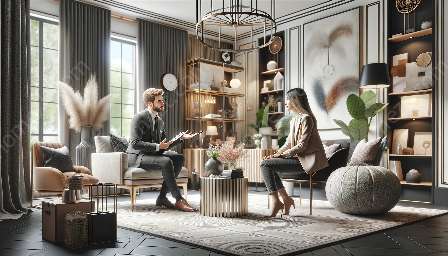Effective client communication is crucial in the interior design and home furnishings industry. Building strong relationships and keeping clients informed are essential for success. In this comprehensive guide, we will explore the importance of client communication, effective strategies, and best practices for interior designers and home furnishing professionals.
The Importance of Client Communication
Client communication is the cornerstone of any successful project. It is essential for understanding the client's needs, preferences, and expectations. Clear and open communication helps to establish trust, manage expectations, and ensure that the final design aligns with the client's vision. Moreover, effective communication can lead to repeat business and referrals, contributing to the success of an interior design or home furnishings business.
Building Strong Relationships
Communication plays a significant role in building strong relationships with clients. Interior designers and home furnishing professionals should strive to create an open and collaborative environment where clients feel heard and valued. By actively listening to clients' ideas and concerns, professionals can gain valuable insights and foster trust and loyalty. Additionally, maintaining regular and transparent communication throughout the project helps to build a positive rapport with clients, leading to long-term partnerships.
Understanding Client Needs
Successful client communication involves a deep understanding of the client's needs, lifestyle, and aesthetic preferences. Design professionals should engage in meaningful conversations with clients to uncover their desires, challenges, and priorities. By asking the right questions and actively listening, designers can gain a comprehensive understanding of the client's vision and deliver tailored solutions that exceed expectations. Open dialogue and clear communication allow for the alignment of the designer's creativity with the client's aspirations.
Effective Strategies for Client Communication
Implementing effective strategies for client communication is essential for interior design and home furnishing professionals. The following tactics can enhance communication and strengthen client relationships:
- Initial Consultation: The initial client meeting is an opportunity to establish rapport, gather information, and lay the foundation for productive communication throughout the project. This is the time to ask open-ended questions, actively listen to the client's ideas, and communicate the designer's approach and process.
- Clear Documentation: Clear and comprehensive documentation, including proposals, contracts, and project timelines, ensures that both parties have a shared understanding of the project scope and expectations. Transparent communication through written documents helps to avoid misinterpretations and disputes.
- Regular Updates: Providing clients with regular progress updates and milestones keeps them informed and involved in the project. Whether through in-person meetings, phone calls, or email communication, keeping the client in the loop fosters a sense of collaboration and trust.
- Visual Aids: Visual aids such as renderings, mood boards, and material samples can facilitate client communication by providing tangible representations of design concepts. Visual tools help clients visualize the proposed designs and make informed decisions, improving overall communication.
Best Practices for Client Communication
Adhering to best practices in client communication can elevate the professionalism and success of interior designers and home furnishing professionals. The following best practices are essential for maintaining effective client relationships:
- Active Listening: Actively listening to the client's needs and concerns demonstrates respect and empathy. By showing genuine interest in the client's perspective, designers can build trust and establish a deeper connection.
- Setting Expectations: Clearly defining project timelines, deliverables, and communication channels sets clear expectations from the beginning. This clarity helps manage the client's expectations and minimizes misunderstandings during the design process.
- Problem-Solving Approach: When challenges arise, effective client communication involves a proactive problem-solving approach. Maintaining transparency, discussing potential solutions, and seeking client input fosters a collaborative environment and builds confidence.
- Feedback Loop: Establishing a structured feedback loop encourages open dialogue and allows clients to share their thoughts and concerns. Actively seeking and incorporating client feedback demonstrates a commitment to delivering personalized and satisfactory outcomes.
Conclusion
Effective client communication is the key to success in the interior design and home furnishings industry. By prioritizing open and transparent communication, building strong relationships, understanding client needs, and implementing effective strategies and best practices, professionals can create exceptional experiences for their clients and establish a positive reputation in the industry. Cultivating a client-centric approach to communication not only leads to satisfied clients but also contributes to long-term business growth and success.


